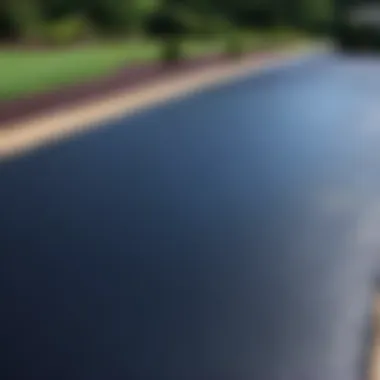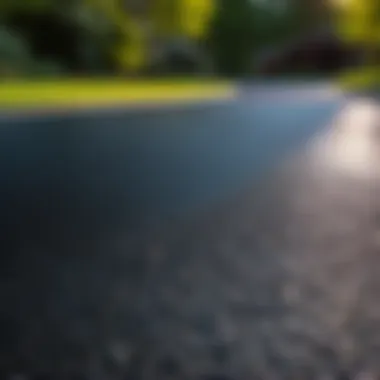Materials:
- Blacktop Resurfacer: 20 gallons
- Crack filler: 5 gallons
- Sealant: 10 gallons
- Pressure washer with nozzle
- Broom
- Wire brush
DIY Steps:
-
Preparation: Begin by cleaning the driveway with a pressure washer and removing any weeds or debris. Fill in cracks with the filler and allow it to dry completely.
-
Mixing and Application: Follow the manufacturer's instructions to mix the blacktop resurfacer. Apply an even coat using a squeegee or trowel, ensuring thorough coverage.
-
Sealing: Once the resurfacer has dried, apply a sealant to protect the surface from moisture and UV damage.
Technical Aspects:
- Timing: Allow for sufficient drying time between each coat to ensure optimal results.
- Tools: Use a pressure washer for cleaning, a broom for sweeping, and a wire brush for crack preparation.
- Techniques: Ensure even application of the resurfacer for a smooth finish.
DIY Project Process:


-
Preparation: Clean and repair any cracks in the driveway surface.
-
Mix and Apply: Follow the recommended mixing ratios and application techniques for the blacktop resurfacer.
-
Sealing: Apply the sealant evenly to protect the newly resurfaced driveway.
Troubleshooting Tips:


- If the resurfacer appears uneven, use a trowel to smoothen out the surface.
- In case of bubbles or blisters, gently puncture them and reapply the sealant.
Enjoy the Result: Admire your newly resurfaced blacktop driveway, boasting enhanced durability and a sleek appearance.
Understanding the Importance of Resurfacing


Resurfacing a blacktop driveway is a crucial aspect of property maintenance that offers numerous benefits. It goes beyond mere aesthetics to encompass functionality, safety, and longevity. By understanding the importance of resurfacing, homeowners can enhance their property's overall appeal and increase its lifespan.
Benefits of Resurfacing a Blacktop Driveway
Enhanced Curb Appeal
Enhanced curb appeal is a key benefit of resurfacing a blacktop driveway. A freshly resurfaced driveway instantly elevates the aesthetic appeal of a property, impressing visitors and passersby. The smooth, well-maintained surface enhances the overall look of the property, contributing to a welcoming and attractive exterior. This feature is particularly beneficial for homeowners looking to boost their property value and stand out in the neighborhood.
Improved Durability
Improved durability is another significant advantage of resurfacing a blacktop driveway. The new layer of asphalt provides a sturdy surface that can withstand heavy use and adverse weather conditions. It enhances the driveway's ability to resist cracking, crumbling, and deterioration, ensuring a long-lasting and functional driveway for years to come. This durability factor is essential for homeowners seeking a low-maintenance and reliable driveway solution.
Prevention of Cracks and Potholes
Resurfacing a blacktop driveway effectively prevents cracks and potholes from forming or worsening. The fresh layer of asphalt fills in existing cracks and smoothens out surface imperfections, creating a seamless and robust driveway surface. By addressing these issues proactively, homeowners can avoid costly repairs and potential safety hazards. This preventive measure adds to the overall longevity of the driveway, making it a practical and prudent investment for property owners.
Determining the Right Time to Resurface
Assessing Current Condition
Assessing the current condition of the blacktop driveway is the first step in determining the right time to resurface. This involves inspecting the surface for cracks, potholes, fading, and signs of wear. Evaluating the extent of damage and deterioration helps homeowners decide whether resurfacing is necessary or if minor repairs can suffice. By understanding the current condition, homeowners can plan the resurfacing project effectively and address potential issues promptly.
Signs of Wear and Damage
Recognizing the signs of wear and damage is crucial in determining the optimal resurfacing time. These signs may include widespread cracks, deep potholes, faded markings, and uneven surfaces. Understanding these indicators allows homeowners to take proactive steps to maintain their driveway's structural integrity and appearance. By identifying wear and damage early on, homeowners can avoid costly repairs and ensure a smooth resurfacing process.
Frequency of Maintenance
Considering the frequency of maintenance is key in determining when to resurface a blacktop driveway. Factors such as the climate, traffic volume, and previous maintenance activities influence how often resurfacing is necessary. Regular maintenance practices, such as cleaning, sealing, and crack repair, can extend the lifespan of the driveway and delay the need for resurfacing. Understanding the maintenance requirements of a blacktop driveway aids homeowners in establishing a routine that promotes long-term durability and performance.
Preparing for Driveway Resurfacing
When it comes to preparing for driveway resurfacing, there are several specific elements that homeowners need to consider to achieve optimal results. These include assessing the current condition of the driveway, gathering the necessary tools and materials, and clearing and cleaning the surface before application.
On a deeper level, preparing for driveway resurfacing is essential to address any existing issues such as cracks, potholes, or damage to the surface. By taking the time to assess these issues thoroughly, homeowners can tailor their approach to the resurfacing process, ensuring that these problems are effectively resolved.
Moreover, proper preparation enhances the adhesion of the new asphalt resurfacer to the existing surface, promoting a smooth and durable finish. It also helps in preventing future cracks or damage by creating a strong base for the new layer of blacktop.
Gathering Necessary Tools and Materials
Asphalt Resurfacer
When it comes to asphalt resurfacing, the choice of asphalt resurfacer is paramount. The specific aspect of the asphalt resurfacer lies in its formulation, designed to rejuvenate and enhance the appearance and durability of the blacktop driveway.
The key characteristic of a high-quality asphalt resurfacer is its ability to fill minor surface imperfections, improve color uniformity, and provide a protective seal for the underlying asphalt. This makes it a popular choice for driveway resurfacing projects, ensuring a smooth and long-lasting finish.
One unique feature of asphalt resurfacer is its ability to bond effectively with the existing asphalt surface, creating a seamless transition between the old and new layers. This not only enhances the aesthetics of the driveway but also reinforces its structural integrity, leading to increased longevity and durability.
Cleaning Equipment
In driveway resurfacing projects, the role of cleaning equipment cannot be overstated. The specific aspect of cleaning equipment lies in its ability to remove dirt, debris, and other contaminants from the surface of the driveway, ensuring a clean and smooth substrate for the new asphalt resurfacer.
The key characteristic of high-quality cleaning equipment is its efficiency in deep cleaning the surface, preparing it for resurfacing. Whether using a pressure washer or specialized cleaning solutions, clean equipment plays a vital role in achieving a professional-grade finish.
A unique feature of cleaning equipment is its versatility in tackling different types of stains and buildup on the driveway surface. By choosing the right cleaning equipment, homeowners can effectively enhance the adhesion of the resurfacer and improve the overall quality of the finished project.
Protective Gear
When undertaking driveway resurfacing, the inclusion of protective gear is essential for ensuring the safety and well-being of the individuals involved. The specific aspect of protective gear lies in its ability to protect against potential hazards such as chemicals, sharp objects, and fumes present during the resurfacing process.
The key characteristic of quality protective gear is its durability and comfort, allowing workers to focus on the task at hand without compromising their safety. Whether it's gloves, goggles, or respirators, protective gear plays a crucial role in minimizing risks and ensuring a secure working environment.
A unique feature of protective gear is its customization options, including different sizes and materials to suit individual preferences and requirements. By wearing proper protective gear, homeowners and workers can confidently tackle the resurfacing project, knowing that they are shielded from any potential harm or injury.
Resurfacing Process
When it comes to resurfacing your blacktop driveway, the resurfacing process is a critical step that can significantly enhance the appearance and lifespan of your driveway. This section details the essential elements, benefits, and considerations involved in the resurfacing process, ensuring a smooth and durable outcome for your property.
Applying the Resurfacer
Mixing the Resurfacer:
Mixing the resurfacer is a pivotal aspect of the resurfacing process. By ensuring that the resurfacer is thoroughly blended, you guarantee a consistent application and optimal adhesion to the existing surface. The key characteristic of mixing the resurfacer lies in achieving a homogeneous mix of aggregate, binder, and additives, which promotes structural integrity and longevity. This meticulous process is a popular choice for driveway resurfacing as it allows for a uniform finish and enhanced durability. The unique feature of proper mixing is that it minimizes the risk of premature wear and cracking, ultimately contributing to a long-lasting blacktop surface.
Even Application Techniques:
Implementing even application techniques is crucial for achieving a seamless and visually appealing driveway resurfacing. The key characteristic of this technique involves distributing the resurfacer evenly across the entire surface, ensuring consistent coverage and thickness. This method is favored for its ability to eliminate uneven spots and enhance the structural integrity of the driveway. By applying the resurfacer evenly, you can prevent premature wear and extend the lifespan of your blacktop surface. The advantage of this technique is evident in the smooth and polished finish it delivers, transforming your driveway into a visually appealing and resilient feature of your property.
Overlap for Consistency:
Utilizing overlap for consistency plays a significant role in ensuring a uniform and well-integrated resurfacing application. The key characteristic of overlapping is the seamless blending of adjacent sections, creating a continuous and cohesive surface. This technique is a popular choice among professionals for its ability to eliminate potential gaps and inconsistencies in the resurfacing layer. By overlapping each application, you guarantee uniform thickness and enhanced durability throughout the entire driveway. The unique feature of overlap lies in its ability to reinforce structural integrity and prevent premature damage, making it an essential practice for achieving a long-lasting and visually appealing blacktop surface.
Smoothing and Leveling
Using Squeegees or Rollers:
In the process of smoothing and leveling the resurfacer, utilizing squeegees or rollers is instrumental for achieving a flawless finish. The key characteristic of using squeegees or rollers lies in their ability to evenly spread the material and eliminate excess buildup, resulting in a uniform surface. This technique is favored for its precision in removing air pockets and ensuring proper compaction, enhancing the overall durability of the resurfaced driveway. The unique feature of squeegees or rollers is their versatility in accommodating different surface textures and ensuring a consistent thickness throughout the application.
Eliminating Excess Material:
Efficiently eliminating excess material during the smoothing and leveling process is crucial for maintaining an even and structurally sound driveway surface. The key characteristic of this step involves carefully scraping off any surplus resurfacer to prevent uneven thickness or buildup. By eliminating excess material, you ensure a uniform appearance and optimal adhesion of the new surface to the existing blacktop. This practice is beneficial for minimizing the risk of premature wear and enhancing the overall aesthetics of the driveway. The advantage of eliminating excess material is evident in the seamless and professional finish it achieves, elevating the visual appeal and longevity of your resurfaced blacktop driveway.
Ensuring Uniform Thickness:
Ensuring uniform thickness throughout the resurfacing process is essential for enhancing the structural integrity and longevity of your blacktop driveway. The key characteristic of maintaining consistent thickness lies in achieving a level surface that can withstand varying weather conditions and traffic loads. This practice is a popular choice for maximizing the durability and aesthetic appeal of the driveway. By ensuring uniform thickness, you minimize the risk of uneven settling and promote long-term performance of the resurfaced blacktop. The unique feature of uniform thickness is its ability to provide a reliable and visually pleasing surface that withstands daily wear and tear effectively.
Curing and Drying
Allowing Sufficient Time for Drying:
Providing adequate time for the resurfacer to dry thoroughly is a critical stage in the resurfacing process. The key characteristic of allowing sufficient time for drying is to promote proper curing and bonding of the new surface, ensuring its resilience and longevity. This practice is a beneficial choice for safeguarding the driveway against premature wear and maintaining its structural integrity over time. By allowing sufficient drying time, you optimize the performance and appearance of the resurfaced blacktop, creating a durable and visually appealing driveway. The advantage of this practice is evident in the long-term stability and quality of the resurfaced surface, offering lasting value for your property.
Avoiding Foot Traffic:
Avoiding foot traffic on the freshly resurfaced driveway is essential to prevent damage and maintain the integrity of the new surface. The key characteristic of this practice is to minimize disturbances that could disrupt the curing process and compromise the adhesion of the resurfacer. By avoiding foot traffic, you ensure a smooth and durable finish that can withstand daily use without premature wear or damage. This technique is a popular choice for preserving the quality and appearance of the resurfaced blacktop, allowing it to cure effectively and achieve maximum durability. The unique feature of avoiding foot traffic is its ability to protect the freshly applied surface and promote long-lasting performance, enhancing the overall value and functionality of your driveway.
Protecting from Rain:
Shielding the freshly resurfaced driveway from rain is crucial to prevent water damage and maintain the effectiveness of the resurfacing process. The key characteristic of protecting from rain lies in creating a barrier that shields the surface from moisture and potential erosion. This practice is a beneficial choice for ensuring the longevity and appearance of the blacktop driveway by preventing water penetration and preserving the integrity of the new surface. By protecting the driveway from rain, you safeguard it against weather-induced wear and maintain its structural stability over time. The advantage of this precaution is evident in the enhanced resilience and lifespan of the resurfaced blacktop, offering enduring protection and visual appeal for your property.
Finishing Touches and Maintenance
In the final phase of resurfacing your blacktop driveway, attention to detail during the finishing touches and ongoing maintenance is crucial to ensuring the longevity and pristine condition of your newly resurfaced area. The efforts put into sealing and maintenance practices are integral for preserving the appearance and functionality of your driveway in the long run.
Sealing the Resurfaced Driveway
Benefits of Sealing
Sealing the resurfaced driveway offers a protective barrier against elements such as water, UV rays, and chemicals that could cause premature wear and deterioration. The key benefit of sealing is its ability to extend the lifespan of your blacktop surface by preventing damage from seepage and oxidation. Choosing the right sealer for your specific driveway type and climate conditions is essential to maximize the protective qualities of the sealant.
Choosing the Right Sealer
Selecting the appropriate sealer type based on the asphalt mix of your driveway and the region's climate is vital for optimal results. A high-quality sealer provides adequate protection against oil spills, moisture penetration, and UV damage. The right sealer enhances the visual appeal of the driveway while offering superior durability and resistance to wear and tear.
Application Techniques
Proper application techniques ensure even coverage and penetration of the sealer into the blacktop surface. Applying the sealant with a squeegee or sprayer in consistent coats guarantees thorough protection and a smooth finish. The unique feature of correct application techniques lies in providing a uniform and level seal layer that seals existing cracks and prevents new ones from forming.
Regular Maintenance Practices
Regular maintenance practices play a central role in preserving the quality of your resurfaced driveway over time. By incorporating routine cleaning, crack repair, and sealant reapplication into your maintenance regimen, you can address minor issues before they escalate, ensuring a well-maintained and aesthetically pleasing blacktop surface.
Periodic Cleaning
Periodic cleaning removes dirt, debris, and stains that can deteriorate the driveway surface over time. Using appropriate cleaning products and techniques helps maintain the appearance and structural integrity of the blacktop. Periodic cleaning not only enhances the curb appeal but also prevents the accumulation of harmful substances that can compromise the sealing properties.
Crack Repair
Addressing cracks promptly through proper repair methods prevents water infiltration and expansion of existing cracks. Effective crack repair restores the integrity of the asphalt surface and prevents further damage caused by freeze-thaw cycles and regular traffic. A key characteristic of crack repair is its proactive approach to preserving the structural strength of the driveway.
Sealant Reapplication
Regularly reapplying sealant to the driveway surface rejuvenates the protective layer and enhances its resistance to external factors. The unique feature of sealant reapplication lies in its ability to rejuvenate the sealing properties, providing ongoing protection against environmental stresses and enhancing the overall longevity of the blacktop driveway. Choosing a suitable reapplication schedule based on usage and climate conditions is vital for maintaining the protective barrier and aesthetic appeal of the driveway.





